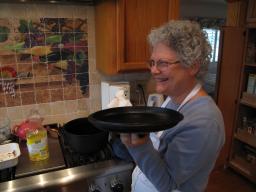
Hamelman


Hamelman rye class in August
Jeffrey Hamelman is teaching another rye bread class this August 23 and 24. I'm considering it and wonder if anyone else is. There are 8 seats left, so I'd have to move pretty quickly on this.
Joy

Bread vs The Fundamental Techniques of Classic Bread Baking
I have both excellent books: Bread (second edition) by Jeffrey Hamelman and The Fundamental Techniques of Classic Bread Baking by the French Culinary Institute.
Oddly enough: the breads I make from Hamelman turn out te be always a big success. Of course, sometimes after the second try but the work, they turn out well.
My breads from FCI never work... I have the impression the doughs are always too wet. Even when the overall formula is almost identical!

Semonlina Bread (Hamelman) - Oven spring
Hello everybody,
I just bought the second edition of Hamelman's Bread.
My question is about oven spring. Since there are hardly pictures in the book, I wonder if every bread should have an oven spring.
I made the Rye Sourdough bread and it was beautiful! A nice ear, the crust open, ...
Then I made the Semoline sourdough bread (with liquid levain) but there is no oven spring (almost none, no ear, ...).
Is that normal? How to tell if a bread should have an oven spring (based on the formula maybe?).
Or was my bread poorly baked?

Beranbaum vs Hamelman
I'm new to bread baking and to this point have only produced basic loaves. I find baking to be most enjoyable but do lack the knowledge required, to improve what I make. I have read a fair amount on TFL and learnt some and thanks is given.
I am interested as a home baker in some of the science behind the subject and as such, considered the following two books Bread: A Baker's Book of Techniques and Recipes which vs The Bread Bible by Rose Levy Beranbaum.

Happy dance!
One of my Christmas presents this year is the second edition of Jeffrey Hamelman's Bread. Lots of good reading and baking in front of me now!
Paul

Hamelman-esque Sourdough Pizza Dough
I am trying to make a sourdough pizza based upon my favorite sourdough recipe, the Hamelman Vermont Sourdough. I've decided that the way to do this is to try to adapt the sourdough recipe to the pizza dough recipe in his Bread book. I'd appreciate any comments or suggestions since this is the first time I have tried to adapt one of the recipes this dramatically:
Vermont Sourdough Pizza Dough
Overall Formula |
|











